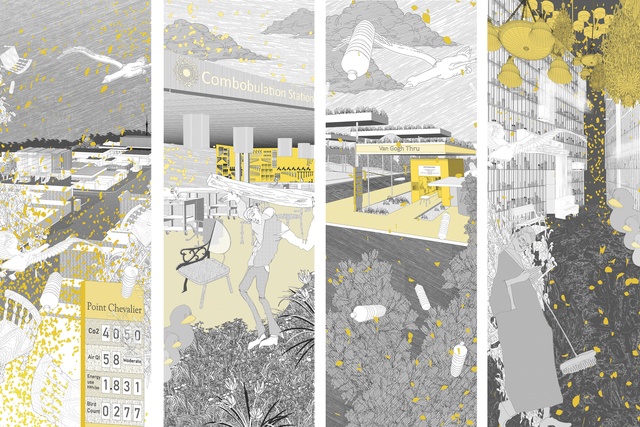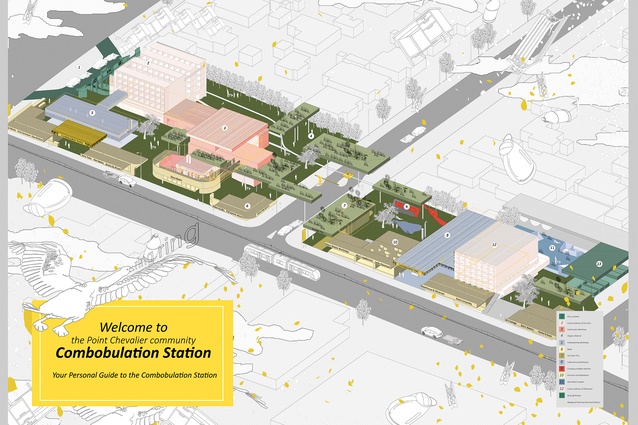Combobulation Station: Uncanny Architecture for Uncommon Objects
The Auckland Architecture Association held their annual Visionary Architecture Awards on 28 February, with the Supreme award going to University of Auckland graduate Nicole Teh for her project Combobulation Station: Uncanny Architecture for Uncommon Objects. Teh also won the Post-graduate category. Here, Teh tells us more about her winning project.
Combobulation Station
Uncanny Architecture for Uncommon Objects
Earth has long staged a hospitable host to humans. However, insatiable consumption has damaged the future of its hospitality. As a new ecological equilibrium unfolds, not only does a physical transformation occur but, so too, must a cognitive transformation. Combobulation Station proposes a cognitive re-orientation in the ecological visions at neighbourhood-scale architecture. Taking note of the prevalent and imminent imperative to incite structural shifts in our material culture, a theoretical investigation re-portrays the everyday Anthropocene.
Culminating as the ‘Combobulation Station,’ an uncanny anthropocentric re-interpretation of community recycling centres facilitates the processing, sorting and transferring of inorganic waste. This station represents a reaction to the feelings of discombobulation of current climate conversations, where the familiarity of everyday habits has been fragmented, provoking the uncanny and the surreal.

More on the above images – From left to right: 01. The former petrol station display boards now exhibit the values from air quality, bird population and energy usage. 02. The ‘Fraken- workshops’ are where locals and station engineers rework the obsolete objects into new, uncanny objects for climate change. 03. The former carwash is now the ‘Van Gogh Thru’, an automated painting station for re-finishing domestic goods. 04. The Curious Cabinets take waste off the ground and consider each item as a valuable resource.
Situated west of Auckland’s central city, down the main stretch of Point Chevalier village at the former McDonald’s, Mobil and Zed petrol stations, the Combobulation Station imagines new quotidian habits that humans adopt in the future, where obsolete domestic objects transform into tools for climate change. A portmanteau of familiarity and unfamiliarity and acts of disassembly and reassembly are encouraged to create these objects. The architecture also represents reassembly, by the adaptive reuse of the former fossil fuel and fast food typologies, as the demand for these building formulas becomes less desirable in the Anthropocene.
The gas station canopy becomes host to the ‘Frankensteining’ workshops, where Anthropocene engineers rework the unwanted objects into new uncanny tools for climate change. The car wash is refitted as the ‘Van Gogh Thru’, an automated painting station where one can take their dinged-up dining table and it is perhaps transformed into a suave new yellow set. The former kiosks are re-adapted as the ‘Curious Cabinets’ to store the categories of collection, where a particularity of organisation takes waste off the ground, challenging the perception of waste as an unwanted commodity but rather as an opportunity for new uncanny resources. Finally, the once-vast asphalted street-front positions are infilled with retail spaces, giving local crafters
or fixer-uppers the opportunity to offer their goods and services to the community.

This adaption of architecture simulates the transformation of all gas stations across urban Auckland over time, servicing their individual suburbs and providing a connected network of resources available locally. These stations are a typology where machines become a part of the natural metabolism and economic success is not only measured in monetary value but, also, by the growth of ecological diversity; at the Combobulation Station the display boards no longer describe the cost of diesel per litre but, rather, they display values for air quality, energy usage and bird population. By reconceptualising the climate future of Auckland, this project, neither dystopian nor utopian but rather an uncanny marriage of both, accepts and embraces the ‘sur-realties’ of the future environment.
Combobulation Station emerges from the position that, supplementary to the thoughts of green thinking or eco-friendliness, architecture’s approach to climate discourse should equally consider its cultural and historical relationships to create the most meaningful response. This project pursues a process that values creative power, fusions, reinterpretations, the uncanny and the thrill of the unexpected, not only as a way of designing but as a way of thinking, in the new changed climate.










